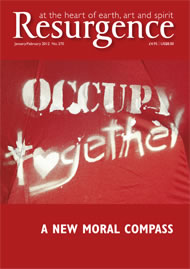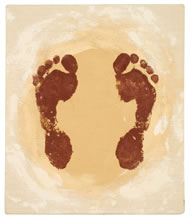It’s a late spring morning and I’m following a dirt track down into Wadi Ain Samia, a verdant valley deep in the Palestinian countryside. With my guide, Habib, I pass through fields of rich, brown earth, fruit orchards and olive groves. I see mules pulling ploughs, and straggly herds of goats whose bells echo across the valley as they have for the past 2,000 years. Soon I forget I’m walking through a troubled land.
Then, amidst the bells and the birdsong, the strains of a flute floating on the breeze; we stop, and Habib points out the Bedouin shepherd across the fields, head enfolded in a keffiyeh. We walk over to say hello and the shepherd explains that the music helps his goats to graze.
This encounter is typical of my walk on Abraham’s Path, a new walking route that retraces the legendary journey made by Abraham (Ibrahim) through the Middle East. His is a story dear to three religions, and one that’s tightly woven into the region’s landscape and culture. In Palestine, the path runs from Nablus to Hebron: 10 days of walking along a narrow sliver of land, between the deserts of the East and the rain shadow of the West.
The trail might end in Hebron (al-Khalil in Arabic), home of Abraham’s tomb, but this is no so-called pilgrimage route. Rather, it’s an opportunity for travellers to get far off the beaten tourist track, offering an experience very different from the conventional Holy Land excursions.
As if to emphasise this, Habib points out a mound topped with straggling stones, the remains of one of four Canaanite cities in this valley; and there are Roman graves nearby too. I sense the benign patience of the landscape, witness to the folly and arrogance of civilisations whose remnants are now left to the sheep and goats. Empires may rise and fall, but the goat bells still chime, and the shepherd still plays his pipes.
Passing Bedouin tented settlements we drop down into the bottom of the valley, to the spring of Ain Samia, after which this wadi is named. The goat and camel hair of the traditional beit as-sha’ar (literally ‘house of hair’) may have been replaced by more modern fabrics, and their occupants may now own mobile phones and rusty pickups, but otherwise life here remains little changed.
As we walk, the scent of herbs, crushed beneath our feet, rises from the earth. Habib picks a sprig of thyme for me. “Zata”, he translates. “Good for the brain. We give it to babies to make them more intelligent.” Mixed with salt and spice, and soaked by bread dipped in olive oil, it’s the breakfast dish that I’ve eaten during many journeys in the Levant.
He then shows me a plant, looking like a wild thistle, which he calls akoub. “The villagers collect it at this time of year. It’s delicious cooked,” he says. “And they sell it to make a little extra money.” We stop under the shade of a pine tree, and Habib collects dried wood to build a fire. He pulls a blackened kettle from his backpack and boils up some tea, dropping a pinch of zata into the brew.
As we sip, Habib points to an Israeli settlement on the nearby hilltop. “Since it was built it’s very hard for the villagers to get into this valley to grow their vegetables and pick the herbs,” he explains. “The settlers have closed the road with two giant boulders. Now it’s a half-hour drive to get here – a journey that used to take two minutes. Or you have to walk, which is very hard for the old people.”
The village he is describing is Kufr Malek, where I’ll stay overnight. Abraham’s Path avoids the major towns, and instead passes through villages, where walkers stay with local families, enabling them to immerse themselves in Palestinian life. Money from hosting guests provides a much-needed additional income for families who are suffering because of the occupation.
Next morning my friend Dan joins me, and we walk together down into Wadi Ganour. This valley, swathed in silence, twists and turns and folds in on itself. The loudest sound is the buzz of a fly, and Dan points out an owl perched on a boulder, oblivious to our presence. Narrow strips of raked earth show where the Bedouin grow a little sparse wheat, making use of every inch of this inhospitable landscape but, unlike modern farming methods leaving no permanent scar.
Dan, along with a team of local Palestinians, was instrumental in planning this route through Palestine. As we walk, he tells me why he believes this is the best way to experience the country. “Walking is fundamental to the way you interact with people, and the way they respond to you,” he asserts. “When you approach a place on foot, you come with a vulnerability you don’t have when you are shielded inside a bus.”
We concur that package tours, set up so you don’t need anything, mean you’re not reliant on the kindness of strangers. As a walker, you become hungry, thirsty and tired. “People respond to your vulnerability with their deepest hospitality,” Dan says, “and then a human interaction takes place that wouldn’t be possible if you arrived with all your arrangements made, and your needs met.”
We climb out of the wadi, and to our camp for the night – the last of my Palestinian walk. This is the Bedouin settlement of Rashayda, set in a landscape of rocks and wind. Sitting on rugs inside our tent we drink glasses of sweet tea, and from the open door I can see the mountains of Jordan just beyond the Dead Sea. A warm breeze lifts the sides of the tent.
Before long the old chief of the tribe, Sheikh Ali al-Rashayda, joins us. He was born in a tent just like this, not far from here, in 1937. There was no hospital to help him into the world, and he has spent his whole life here, in these desiccated hills. His lined face, eyes like gems, tells a story of hardship and happiness, of a man living at one with Nature.
Wrapped in the cosy conviviality of the tent, everyone sits on the ground eating food from the same dish. Later over tea the old man regales us with stories of his past life, and the old ways of the Bedouin, now dying. When darkness falls, the lights of Jerusalem shimmer on the skyline.
As I fall asleep I gaze up through the woven roof of Sheikh Ali’s tent at the bright moon splintered into stars, reflecting on how the age-old Bedouin custom of receiving guests is intimately tied up with the timeless Abrahamic narrative of hospitality. It’s a fitting end to my journey on Abraham’s Path. Walking through any landscape is a meditation, but walking through this land feels like a prayer.
For more information: www.walkpalestine.com www.masaribrahim.ps








